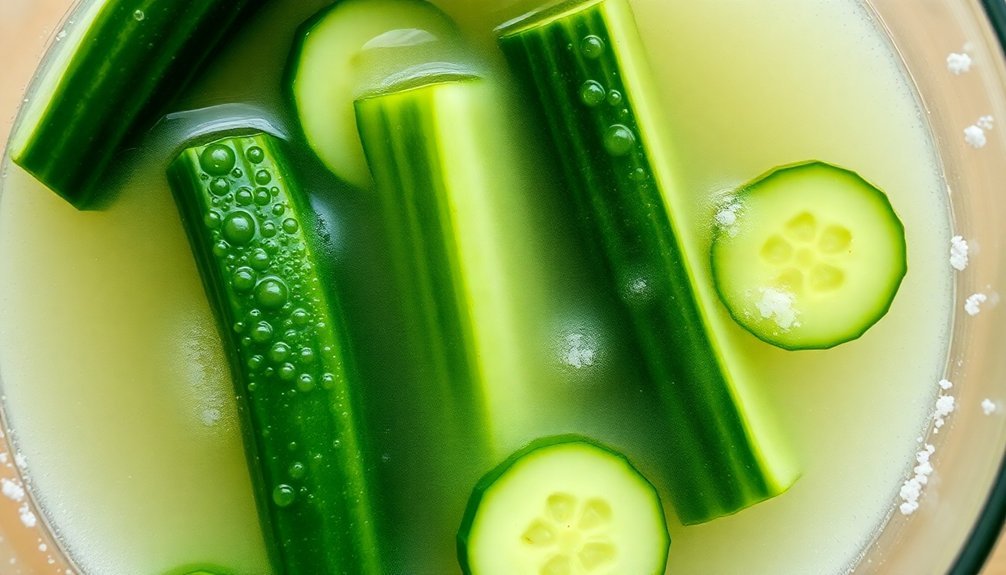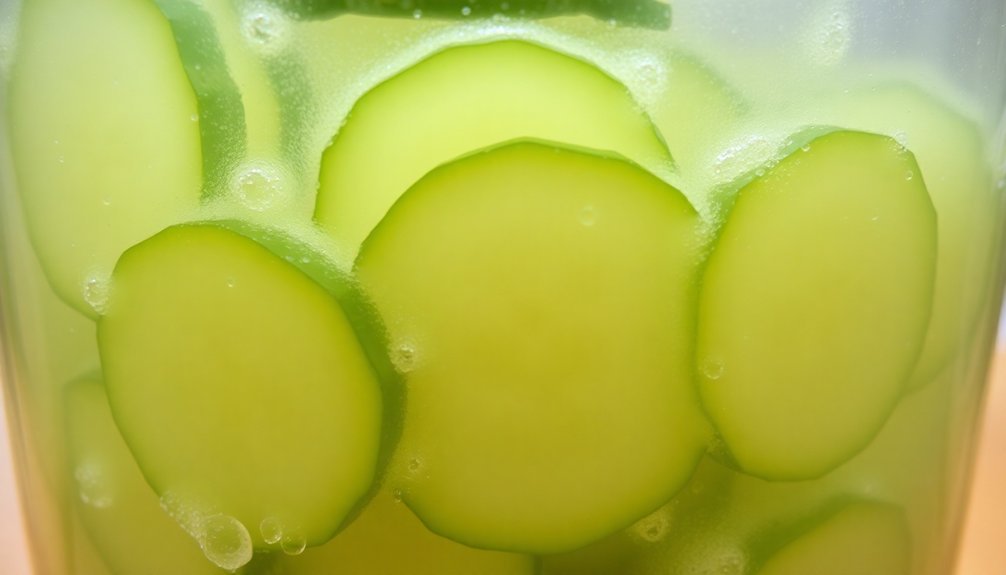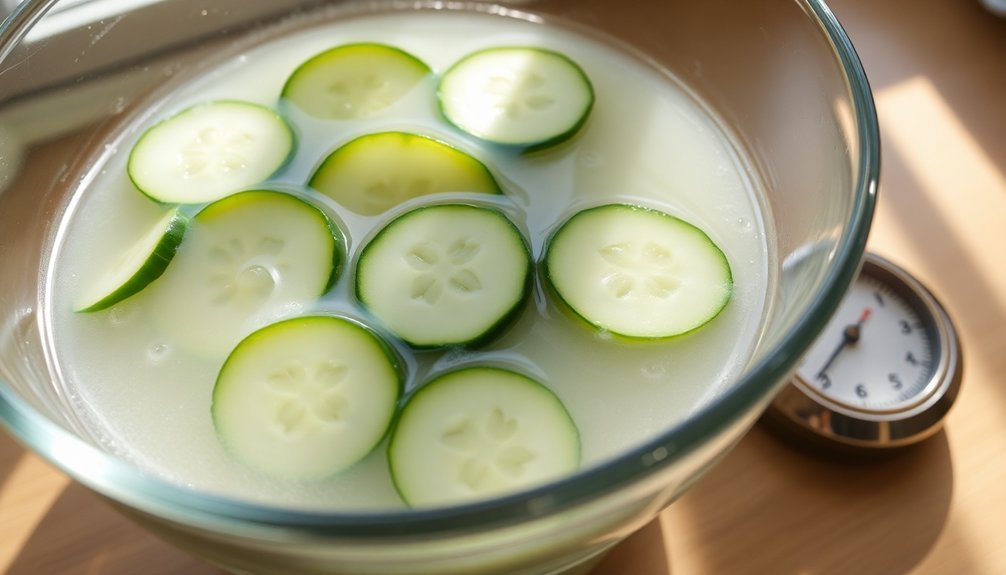Brining your cucumbers before pickling creates crunchier, more flavorful pickles through several key processes. The salt solution draws out excess moisture while strengthening cell walls, which gives you that satisfying snap when you bite into them. It also creates the perfect environment for beneficial bacteria like Lactobacillus to thrive, enhancing preservation and developing complex flavors. You'll want to soak your cucumbers in a precise salt-water solution for 12 hours to 7 days, keeping them fully submerged with weights. Adding natural tannins like grape leaves can boost firmness even further. Understanding the proper salt ratios and timing will transform your pickling results.
Why Brine Your Cucumbers

Properly brining cucumbers before pickling creates the foundation for crisp, flavorful pickles that'll last. When you brine your cucumbers, you're taking essential steps to enhance both their texture and taste while ensuring proper preservation. For best results, Kirby cucumbers are the traditional choice due to their thick, bumpy skin.
You'll achieve better crunchiness by soaking your cucumbers in ice water or cold brine, and you'll reduce any natural bitterness in the process. By cutting off the blossom end, you'll remove an enzyme that can make your pickles turn mushy. When you slice your cucumbers, you're allowing the brine to penetrate more evenly through the skin and flesh.
The brine solution does more than just improve texture – it's vital for preservation. It inhibits unwanted microorganisms while supporting beneficial bacteria, especially in fermented pickles. You're creating an environment that extends freshness and reduces spoilage risk during pickling.
You'll also enhance flavor through brining. The solution combines salt, sugar, and various seasonings that infuse your cucumbers with balanced taste. Whether you're adding dill, garlic, or other spices, the brine helps develop complex flavors, including rich umami notes in fermented varieties.
Benefits of Proper Brining
When you brine your cucumbers before pickling, you'll get better crunch and texture through the salt's ability to draw out excess moisture while strengthening cell walls.
The salt penetration process during brining creates an ideal environment for beneficial bacteria to thrive, leading to enhanced preservation and food safety.
Your cucumbers will develop deeper, more complex flavors as the brine works its way through the vegetable, resulting in a better-tasting final product. Soaking cucumbers in a cold saltwater solution for 12 hours to 7 days helps achieve optimal pickle flavor and quality.
Maintaining Crunch and Texture
The art of maintaining crisp, crunchy pickles begins with proper brining techniques. You'll need to start by removing the blossom end of your cucumbers and inspecting them for any soft spots or blemishes. This essential first step eliminates enzymes that can make your pickles soft and guarantees only the firmest cucumbers make it into your brine. Adding kosher or pickling salt is crucial for creating an effective brine solution.
To maximize crunchiness, you'll want to soak your cucumbers in cold saltwater brine for 12 hours to 7 days. Keep them submerged in the refrigerator with a weight to guarantee even brining. You can enhance the firmness by adding natural tannins like grape leaves or horseradish leaves to your brine, along with mustard and dill seeds for added texture and flavor.
Before the final pickling process, you'll benefit from cooling your cucumbers in ice water to slow down enzymatic reactions.
For long-term storage, you can process your pickles in 180°F water for 30 minutes or use a lime-water solution (with proper lime removal afterward). These steps will help guarantee your pickles maintain their satisfying crunch whether you're making fermented or canned varieties.
Salt Penetration Process
Salt penetration transforms your cucumbers through a fascinating osmotic process during brining. When you submerge cucumbers in brine, salt dissolves in water and triggers a two-way exchange: water moves out of the cucumber cells while salt moves in to balance the concentrations. This process helps season your cucumbers deeply while reducing their water content.
You'll find that as the salt penetrates, it creates significant cellular changes. The water drawn out from the plant cells concentrates the flavors, while the cell walls become slightly dehydrated, making them more receptive to additional seasoning. This transformation is essential for both texture and taste development.
The salt penetration process doesn't just enhance flavor – it's also critical for food safety. High salt concentrations inhibit harmful bacteria while creating an environment where beneficial bacteria like Lactobacillus can thrive. This microbial control guarantees your pickles will be safe to eat.
The process also sets the stage for successful fermentation. When you've achieved proper salt penetration, you'll have cucumbers that are perfectly prepared for the fermentation phase, where they'll develop their characteristic sour taste and maintain their crunch.
Enhanced Flavor Development
Proper brining reveals a world of complex flavors in your pickled cucumbers. When you combine high-grade vinegar with whole spices and fresh herbs, you'll create a brine that transforms ordinary cucumbers into a delectable treat.
The careful balance of water, vinegar, and salt creates the perfect environment for flavors to develop and meld together.
You'll enhance your pickle's flavor profile through these essential steps:
- Start with soft water and quality vinegar in your preferred ratio (1:1 is standard, but you can increase vinegar for tangier results).
- Add whole spices like coriander, mustard seeds, and peppercorns, bundled in cheesecloth for even distribution.
- Incorporate fresh herbs such as dill and bay leaves, along with garlic and jalapeños for depth.
- Consider adding sweet elements like sugar to balance the tartness.
The key to maximum flavor development lies in timing. Let your brine cool completely before adding it to the cucumbers, then pack them tightly in jars.
As your pickles rest in the refrigerator, you'll notice the flavors becoming more complex and harmonious over time.
For fermented varieties, remember to release built-up gases daily by burping the jar.
Salt Water Ratios Matter

When you're mixing your salt water brine, getting the ratio right makes all the difference between crisp pickles and mushy failures.
You'll need to measure carefully, as too strong a brine can actually burn your cucumbers, while too weak a solution won't properly transform their texture.
For consistently perfect results, stick to the standard ratio of ¾ cup salt per 2 gallons of water, and you'll hit the sweet spot that promotes proper fermentation and maintains the cucumber's crunch.
Strong Brine Burns Cucumbers
Creating the perfect brine concentration stands as one of the most critical steps in pickle-making, as incorrect ratios can literally "burn" your cucumbers with salt.
When you use too much salt in your brine, you'll damage both the texture and flavor of your cucumbers, making them potentially inedible.
The ideal ratio for salt-brined pickles is 1.5 tablespoons of kosher salt per 2 cups of water. You'll want to confirm the salt fully dissolves and the brine cools before adding your cucumbers.
If you're noticing issues with your pickles, you might be experiencing salt burn effects:
- Your cucumbers become unusually soft or develop an unpleasant, mushy texture
- The natural cucumber flavor and added spices are completely overpowered by saltiness
- The pickles show signs of improper preservation or early spoilage
- The finished product lacks the signature crunch you're looking for
To avoid these issues, always test your brine before adding cucumbers.
Remember that excessive salt won't provide additional preservation benefits – it'll only harm your pickles.
You can balance the flavor by including complementary ingredients like garlic, dill, and other spices while maintaining the proper salt ratio.
Salt Affects Pickle Texture
Through the delicate balance of salt and water, pickle texture transforms from ordinary cucumber to perfectly crisp preservation. The precise ratio of salt to water determines whether you'll achieve that satisfying crunch or end up with mushy disappointment. A 3% brine solution works best for short fermentation periods of 3-5 days, requiring 7 grams of salt per cup of water, while longer fermentation needs a 4.5% solution with 10.8 grams of salt per cup.
You'll want to use fine-grained pickling salt rather than kosher or sea salt, as it dissolves evenly and prevents gritty residue in your brine. The salt works through osmosis, drawing excess water from the cucumbers while maintaining their structural integrity. This process isn't just about texture – it's vital for preservation too.
If you don't get the ratio right, you'll risk either over-salting, which kills beneficial bacteria, or under-salting, which allows harmful bacteria to thrive. The proper salt concentration guarantees your pickles stay crisp and firm while developing complex flavors during fermentation.
This careful balance helps maintain the vegetables' natural crunchiness while preventing unwanted bacterial growth.
Perfect Brine Measurement Tips
A kitchen scale becomes your most valuable ally in achieving perfect pickle brines. You'll want to maintain a precise 3% salt concentration for safe fermentation, which means using 7 grams of salt per cup of water.
Don't be tempted to use reduced-sodium salt, as it won't provide the proper environment for fermentation and could lead to spoilage.
For consistent results, you'll need to:
- Measure exactly 7 grams of salt per cup of water for a standard 3% brine, or 10.8 grams per cup for a stronger 4.5% brine
- Use filtered or non-chlorinated water at room temperature to guarantee proper fermentation
- Maintain the same ratio when scaling up or down (1 teaspoon salt per ½ cup water)
- Cool your brine completely before adding it to the cucumbers
Your brine measurements must be precise – too little salt allows harmful bacteria to grow, while too much can halt fermentation altogether.
If you're making full sour pickles, you'll want to use the stronger 4.5% brine. Remember to keep detailed notes of your measurements, as consistency is key to reproducible results.
Texture Enhancement Through Brining
Successful pickle-making depends heavily on proper brining techniques to achieve that sought-after crunch.
You'll want to start with small pickling cucumbers harvested within 24 hours, selecting ones that are light-skinned and warted, no more than 2 inches in diameter. Trim the ends and soak them in ice water overnight to enhance their crispness before brining.
Your brine's salt concentration is essential – use only canning or pickling salt to avoid cloudy liquid and skip reduced-sodium options that won't ferment properly. The salt draws moisture from the cucumbers while creating an ideal environment for beneficial bacteria and preventing unwanted microorganisms.
You can boost your pickles' firmness by adding calcium chloride or food-grade pickling lime to your brine. If you're using lime, you'll need to rinse thoroughly afterward.
When preparing the brine, dissolve 1 tablespoon of salt in 2 cups of moderately soft water, letting it cool to room temperature. Pack your cucumbers tightly, ensuring they're fully submerged using a fermentation weight.
This careful attention to the brining process will reward you with perfectly crisp, crunchy pickles.
Microbe Development During Brining

The brining process doesn't just enhance texture – it creates a perfect environment for beneficial microorganisms that transform your cucumbers into pickles. When you create the right salt concentration in your brine, you'll establish conditions that favor lactic acid bacteria (LAB) while inhibiting unwanted spoilage microbes.
During brining, you'll see several key developments:
- LAB begin to thrive in the salty environment, while harmful bacteria can't survive.
- These beneficial bacteria convert the cucumber's natural sugars into lactic acid.
- The rising acidity creates a preservative effect and develops the classic pickle flavor.
- The acidic, salty environment continues to prevent spoilage organisms from growing.
You'll need to maintain temperatures between 70°F and 75°F to support ideal LAB growth. It's essential that you keep oxygen exposure to a minimum by keeping your cucumbers submerged and your fermentation vessel covered.
If you're monitoring the process, you'll notice the brine becoming cloudy as fermentation progresses. Remember that too much or too little salt can disrupt this delicate microbial balance – you'll want to measure carefully to create the perfect environment for successful fermentation.
Best Salt Types For Brining
Selecting proper salt stands as one of the most essential decisions you'll make when brining cucumbers. When choosing your salt, you'll want to avoid iodized table salt and any salts containing anti-caking agents, as these can interfere with the fermentation process and lead to cloudy brine.
Instead, opt for pure Himalayan salt or unrefined sea salts like Celtic Sea Salt, which don't contain harmful additives.
You'll need to dissolve your chosen salt in hot water to create an effective brine, typically aiming for a 5% concentration when fermenting cucumbers. Make certain you're using filtered water, as chlorine can inhibit beneficial bacteria growth.
The salt creates an environment where good bacteria thrive while harmful ones can't survive, helping maintain your cucumbers' crunchiness throughout the process.
Don't be tempted to use reduced-sodium salt or salt substitutes, as they won't provide the necessary environment for proper fermentation.
Remember to fully submerge your cucumbers in the brine, leaving adequate headspace in your jar. This careful attention to salt selection and proper brining technique will guarantee successful fermentation and delicious pickles.
Common Brining Mistakes

While proper salt selection forms the foundation of pickling, many home canners stumble when it comes to the actual brining process. Understanding common mistakes can help you avoid disappointing results and guarantee your pickles turn out crisp and flavorful.
- You'll run into trouble if you don't maintain the correct salt concentration. Using too little salt leads to soft, slippery pickles, while too much causes shriveling. Always stick to your recipe's specified measurements and use vinegar with 5% acidity.
- Temperature control is essential – don't let your cucumbers sit in environments above 75°F. Start the pickling process within 24 hours of harvest, and maintain temperatures between 70-75°F during fermentation.
- Size matters when selecting cucumbers. Choose fresh, firm specimens and remove blossom ends to prevent bitterness. If you notice cucumbers floating during washing, remove them as they're likely hollow and won't pickle properly.
- Don't overlook sanitation. Remove surface scum from the brine regularly, use clean equipment, and guarantee proper jar sterilization. Process your pickles in a boiling-water canner and check that lids are sealed tightly to prevent contamination.
Essential Brining Equipment
Successful pickle brining depends heavily on having the right equipment at your disposal.
You'll need several types of containers, including a large stockpot for heating brine and wide-mouth mason jars or fermentation crocks for the actual pickling process. Make sure you've got appropriate lids and covers – both two-part canning lids and standard metal or plastic lids will work for different applications.
Vital utensils include a bubble remover, unchipped enamelware or stainless steel tools for heating liquids, and precise measuring equipment.
Don't forget a tamper or spoon for ensuring proper submersion. You'll also need weights to keep your cucumbers under the brine – fermentation weights or a weighted plate system work well.
For safe and effective brining, you'll want to stock up on cheesecloth or butter muslin for making spice bundles, and clean towels for covering container openings.
It's essential that all your equipment is thoroughly cleaned and sanitized before use.
Remember to choose containers and utensils made from non-reactive materials like glass, food-grade plastic, or stainless steel to prevent any unwanted chemical reactions during the brining process.
Timing Your Brine Process

Now that you've gathered your equipment, understanding the brining timeline will make or break your pickle-making success.
You'll need to monitor your cucumbers through distinct phases, each with its own characteristics and requirements.
Start by properly preparing your cucumbers – trim the ends, soak them in an ice bath for crunch, and pack them tightly in your jar with adequate headspace.
During the first 72 hours, you'll notice the initial signs of fermentation as bubbles begin to appear, though the brine remains relatively clear.
The active fermentation stage kicks in between days 3 and 7, when you'll observe:
- Increased bubble production and cloudy brine as Leuconostoc bacteria become active
- Color change from bright to olive green
- Development of a pleasant sour aroma as *Lactobacillus* takes over
- Need for regular jar burping to release built-up CO2
Your pickles will be ready for tasting after 7-14 days, when the *Lactobacillus* population peaks and fermentation slows.
You'll know they're done when bubbling subsides and your desired tanginess is achieved.
Transfer them to the refrigerator to halt fermentation and preserve their crunch.
Frequently Asked Questions
Can I Reuse Cucumber Brine for a Second Batch of Pickles?
You can reuse pickle brine for a second batch, but only for refrigerator pickles, not canning. Use it within two batches max, and make sure you're keeping everything refrigerated for safety.
Will Adding Sugar to the Brine Affect the Fermentation Process?
You can add sugar to your brine without disrupting fermentation, as lactic acid bacteria primarily feed on cucumber carbohydrates. It'll mainly affect flavor by balancing acidity, but won't impact the preservation process.
Should Cucumbers Be Peeled Before Brining Them?
You shouldn't peel cucumbers before brining them. The skin helps maintain crunchiness and protects the cucumber's texture during pickling. Plus, it adds nutritional value and contributes to the overall flavor of your pickles.
Can I Use Iodized Table Salt if I Run Out of Pickling Salt?
While you can use iodized table salt, it's not ideal since it'll make your brine cloudy and may affect flavor. The additives won't dissolve properly. You're better off waiting until you can get pickling salt.
What Happens if Cucumber Slices Float Above the Brine During Fermentation?
If your cucumber slices float above the brine, they'll likely spoil and develop mold. You'll need to keep them fully submerged using weights or a plate to guarantee proper fermentation and safe results.
In Summary
Brining your cucumbers before pickling isn't just an optional step – it's vital for crisp, flavorful results. You'll create a better texture by drawing out excess water through osmosis, which helps prevent soggy pickles. When you brine correctly with the right salt ratios and timing, you're also encouraging beneficial bacteria growth that enhances flavor while inhibiting spoilage. Don't skip this crucial prep step if you want perfect pickles.





Leave a Reply